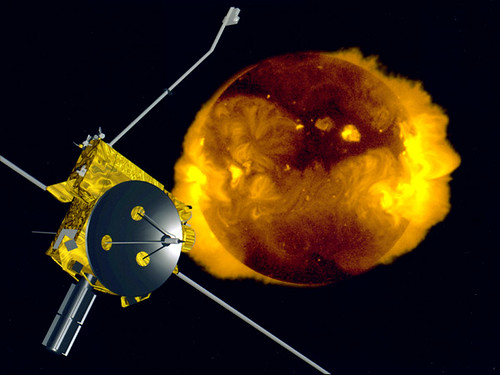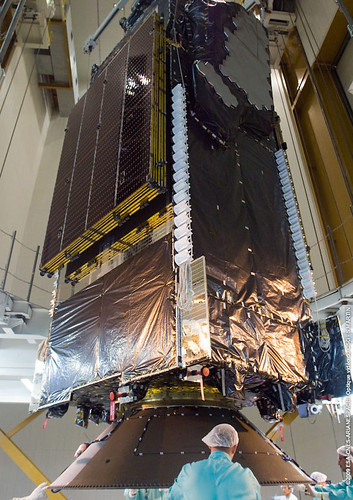WBMSAT News Bits for August 28, 2009
Friday, August 28th, 2009TerreStar-1 completes in-orbit testing and is operating normally.
[Satellite Today – 08/28/2009]
William H. Robbins, 82, a retired NASA scientist who was part of a NASA team honored with an Emmy in 1985 for improving satellite-communications technology, died Saturday in Cleveland.
[philly.com – 08/27/2009]
Planned for launch today, August 28, the space shuttle Discovery is to carry aloft Leonardo, the Multi-Purpose Pressurized Logistics Modules developed by Thales Alenia Space; the MPLM will carry 15,200 pounds of cargo needed for scientific experiments and to support the International Space Station’s crew.
[SatNews – 08/27/2009]
GPS IIR-21(M), the last of the modernized GPS IR satellites, is declared operational for users just 10 days after launching from Cape Canaveral.
[SatNews – 08/27/2009]
WildBlue demonstrates how it can deliver download speeds that are up to 12 times faster than its current speeds if it gets a new high-capacity satellite that could cost around $500m to build, launch, and insure; the company hopes to get stimulus money to help with the cost.
[SatNews – 08/27/2009]
Shaw Direct will launch AMC in HD in Canada by satellite, the first to bring Quebec the award-winning series in HD.
[Marketwire – 08/27/2009]
The National Geospatial-Intelligence Agency certifies and accepts the Space Based Infrared Systems, Highly Elliptical Orbit data for use in support of technical intelligence missions.
[SatNews – 08/27/2009]
Landsat 5 is again in good health after reported difficulties resulting in the halt of imagery operations; the one millionth scene download, of the Grand Canyon, is available on the internet at no cost.
[SatNews – 08/27/2009]
The National Oceanic and Atmospheric Administration and the Japan Aerospace Exploration Agency unveil a new ground station in Guam that will track spacecraft from JAXA’s upcoming Quasi-Zenith satellite system, designed to work seamlessly with the U.S. Global Positioning System and provide improved navigation satellite coverage over Japan and surrounding areas.
[SatNews – 08/27/2009]
Japan Aerospace Exploration Agency is spending $213m to develop a small launch vehicle in 2010 to reduce satellite launch costs by two-thirds.
[Satellite Today – 08/27/2009]
South Korean satellite launch failed when fairing did not open, causing satellite to overshoot the target altitude; satellite likely burned up in the atmosphere during re-entry.
[Bloomberg – 08/26/2009]
Sirius XM Radio unveils a dock that turns an iPhone into a satellite radio receiver, letting users listen to premium satellite radio programming.
[Reuters – 08/26/2009]
The Indian Space Research Organisation plans launch of Oceansat-2, a unique integrated satellite to track marine life and identify potential fishing zones, in September.
[SatNews – 08/26/2007]
Univision expects to realize as much as $175m in 2009, and $350m over next three to five years, from 140 multiyear retransmission-consent agreements with U.S. cable and satellite operators.
[Multichannel News – 08/26/2009]
Globalstar Inc. subsidiary SPOT LLC satellite GPS Messenger will be sold in Best Buy retail locations nationwide.
[Global Newswire – 08/26/2009]
Vizada partner Compass Systems recognized for outstanding customer service to government clients.
[BusinessWire – 08/26/2009]
ProtoStar will auction its two satellites on October 14 following decision by U.S. Bankruptcy Court of Delaware approving the sale.
[Satellite Today – 08/25/2009]
Iridium is contracted buy government of Newfoundland and Labrador to provide satellite service to motorists along Canadian highway.
[Satellite Today – 08/25/2009]
Lockheed Martin satellite built for Sky Perfect JSAT of Japan was successfully launched by Arianespace on Friday, August 21.
[Business Journal – 08/24/2008]
First launch of a Russion Soyuz rocket from the European Space Agency base at Kourou in French Guiana is postponed until April 2010 due to a delay "linked to a mobile launch pad."
[SatNews – 08/26/209]
Kazsat, Kazakhstan’s first satellite, built by the Russian Krunichev Space Center and orbited in June 2006 will be be discarded; control of the satellite was lost in June 2008, restored, then lost permanently in October 2008.
[SatNews – 08/24/2008]
GSA and DISA form satellite communications partnership to create a common marketplace for commercial satellite communications services offering significant savings to defense and civil agencies as well as local and tribal governments.
[hotindienews – 08/24/2009]
SkyTerra Communications is 70.7% owned by Philip Falcon’s Harbinger Capital Partners hedge fund as disclosed in an amended 13D filing with the SEC due to activity on August 19.
[seeking alpha – 08/24/2009]
NASA may turn to private contractors for much of the work now handled by government workers in effort to cut $30b to $50b from program to return astronauts to the moon.
[SatNews – 08/24/2009]
DirecTV, after being rated the nation’s highest-rated TV provider six years in a row, loses its top ranking to AT&T’s U-Verse and Verizon’s FIOS TV.
[Multichannel – 08/24/2009]
Three months after launch, TacSat-3 completes calibration phase and begins crucial validation stage.
[SatNews – 08/24/2009]
Saturday morning Australian time, Optus D3 is successfully launched from French Guiana, slated to provide services for Australia and New Zealand.
[SatNews – 08/23/2007]
Cyprus satellite communications provider Planetsky enters new markets with VelocitySAT services including cellular and PSTN/PTT backhaul, VoIP, IP Backbone, Broadcasting, FPN’s, virtual DSL, Disaster Recovery, and space segment availability.
[pr.com – 08/23/2009]
Russia plans 3-decade manned space flight program; hopes program will be basis for international effort with target direct to Mars as well as a permanent base on the moon.
[IEEE Spectrum – 08/20/2009]
WBMSAT PS – Satellite Communications Consulting Services










